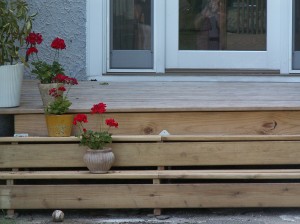Today, I have the great honor of guest posting at Simple Mom, a wonderful, practical and easy-going spot on the web for home managers. The subject of the day is problem solving and the deck I built a few years ago.
You’ve probably figured out by now that math in your everyday life isn’t much like the worksheets and timed drills you suffered through in elementary and middle school. And in the real world, you can leave those way, way behind.
That’s because grownup math has more to do with problem solving than remembering that 7 times 8 is 56. Most of us don’t use trigonometry or calculus. But basic math skills figure into some of the most critical decisions of each day—how to save money, save time and save your sanity. These days, you need to know how much top soil to order for your flower bed or what time your parents will arrive in Boston, if they’re driving in from St. Louis.
Four summers ago, I decided to build a deck—something I’d never done before. This process taught me a lot about the math I already knew and how to fill in the gaps with some pretty simple problem solving skills.
Read the rest of the post, and comment there to win one of 10 paperback copies of Math for Grownups. (You can comment here, but it won’t get you in the drawing, so make sure to head over to Simple Mom.)
Film Friday is taking the day off (it’s basement is flooded and it’s worried that its rare collection of film reels–including outtakes of Citizen Kane where Orson Wells reveals that “Rosebud” is actually a reference to the Fibonacci Sequence–might be under water), but you can check out past Film Friday editions, if you really miss it.Save


